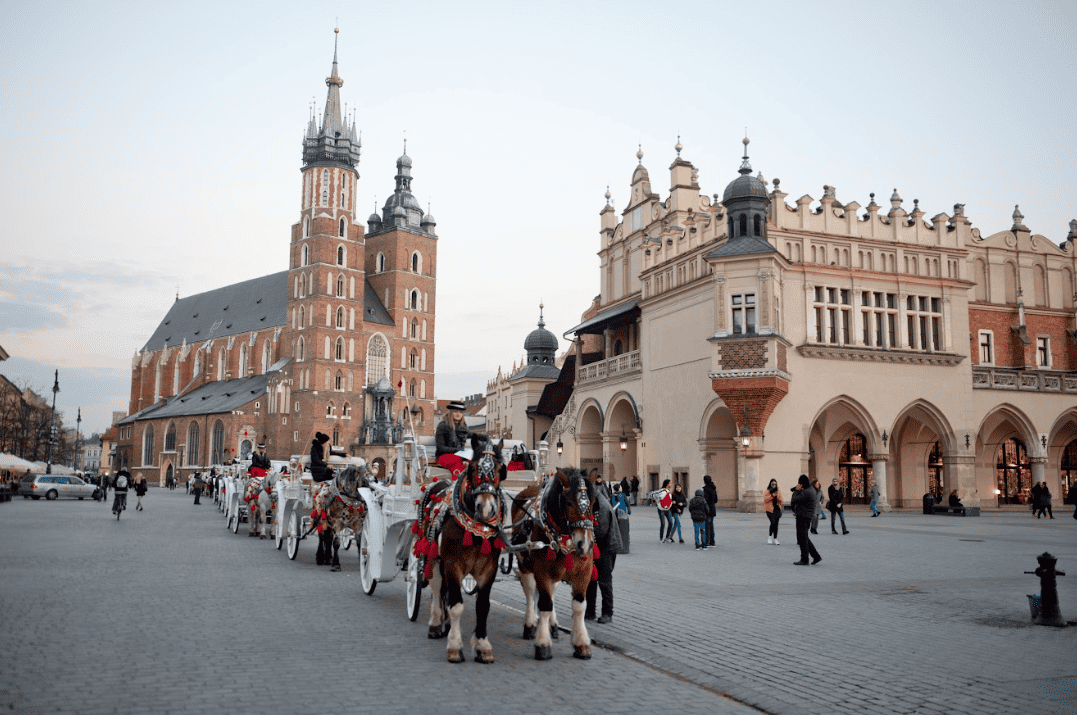Discovering Krakow’s culinary treasures is an adventure that begins with the Food Tour Krakow. This journey takes you through the city’s flavors, linking each bite to a chapter of history. Krakow, with its vibrant food scene, offers a window into Poland’s soul.
In this lively city, food goes beyond sustenance; it’s a celebration of culture. Krakow, known for its scenic beauty and rich past, has always been a mix of various influences. This blend is not only evident in its architecture and art but also in the flavors that dance on your palate. From royal feasts to humble family meals, the city’s history is savored in every bite.
Our focus today is on three traditional dishes that define Krakow’s culinary identity: Zapiekanka, Pierogi, and Beetroot Soup with Polish Sausage. Each of these dishes offers a unique taste and an intriguing backstory. As we unravel the layers of these iconic foods, we also uncover the essence of Krakow itself – a city that has withstood the test of time and continues to enchant visitors with its flavors and stories.
A Glimpse into Krakow’s Past
Krakow’s culinary heritage is very diverse, with different influences. The city, known for its deep-rooted traditions, has seen significant influences shape its food culture.
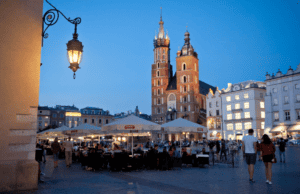
Royal Influence and the Jagiellonian Dynasty: The Jagiellonian dynasty, ruling from the late 14th to the late 16th century, marked a period of cultural and political significance. This era saw Krakow hosting lavish royal feasts, blending diverse European culinary influences. Such opulent dining experiences left a lasting imprint on the city’s gastronomy, with traditional dishes echoing the grandeur of royal cuisine.
Krakow in the Middle Ages and Renaissance: During the Middle Ages, Krakow emerged as a key trading center, and this period’s influence is still visible in the city’s historic architecture and cuisine. The Renaissance further enriched the city’s cultural landscape, leaving architectural gems like the Wawel Castle, a symbol of Krakow’s royal heritage. These periods contributed significantly to the city’s culinary evolution, integrating various European flavors into local dishes.
Communist Era and Modern Adaptations: In more recent history, Krakow’s role during the communist era and its subsequent evolution in the post-communist period have also influenced its culinary scene. The city has masterfully blended its historical recipes with modern culinary techniques, offering a unique dining experience that pays homage to its past while embracing contemporary trends.
Modern Krakow’s Culinary Scene
Protected Designation of Origin and Local Pride: Krakow’s inclusion in the European Union has led to a renewed pride in regional food products. The EU Protected Designation of Origin (PDO) list, akin to a UNESCO World Heritage List for foods, highlights unique products that are deeply rooted in their geographical origins. This initiative has helped preserve traditional recipes and promoted local culinary delights.
Influence of Galicja:The cuisine of Krakow has been shaped significantly by Galicja, part of the former Austria-Hungary, of which Krakow was once a part. Galicja’s culinary traditions, with their emphasis on meats, extravagant desserts, and rich flavors, have left an indelible mark on Krakow’s cuisine. Today, these influences are evident in the city’s cafes, bakeries, and markets, with dishes like schnitzel, head cheese, and Krakow sausage being local favorites.
Krakow’s Street Food and Contemporary Offerings: Krakow’s streets teem with a variety of traditional and modern culinary offerings. From the iconic obwarzanek, a historical street food, to contemporary reinterpretations of traditional dishes in local restaurants, the city’s food scene is a vibrant mix of old and new. Kazimierz’s Zapiekanka and Starowislna’s ice cream are just a few examples of how traditional recipes continue to thrive alongside modern culinary creations.
Krakow’s Classics on the Food Tour Krakow
On the Food Tour Krakow, three traditional dishes stand out for their history and tradition. Let’s take a look into each of these culinary delights.
-
Zapiekanka: Krakow’s Street Food Delight

The story of Zapiekanka begins in the post-war era of Poland. Emerging as a street food staple, it reflects the nation’s resilience and adaptability. This simple yet savory dish, often referred to as a Polish pizza, originated in the 1970s. It was born out of necessity during times of food shortages and has since evolved into a beloved snack across Poland.
Today, Zapiekanka is more than a quick bite; it’s a symbol of Poland’s culinary ingenuity. Often found in the busy Kazimierz district, it represents the fusion of traditional Polish flavors with modern tastes. The dish’s popularity reflects Krakow’s vibrant street food culture, which has been thriving for decades.
The classic Zapiekanka starts with a halved baguette or a long roll, topped with sautéed mushrooms, cheese, and a variety of toppings, finished with a drizzle of ketchup. Each vendor adds their own twist, making it a versatile and personalized dish
-
Pierogi: Poland’s Comfort Food
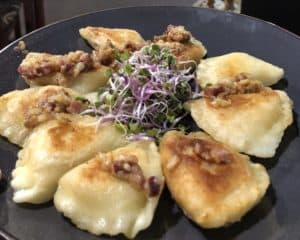
Pierogi’s journey in Polish cuisine is a tale of culinary evolution. These stuffed dumplings have origins tracing back centuries, embodying a mix of cultural influences from across Europe. Each region in Poland has its own unique take on Pierogi, showcasing the diversity within the nation’s culinary traditions.
In Krakow, Pierogi are not just food; they’re a cultural icon. From classic fillings like potatoes and cheese to more innovative versions, Pierogi in Krakow demonstrate the city’s culinary creativity and respect for tradition.
Crafting Pierogi is an art form, involving the careful preparation of the dough and fillings. Whether served boiled or fried, each Pierogi is a labor of love, often featuring in family gatherings and festive celebrations.
-
Beetroot Soup and Polish Sausage: A Traditional Harmonization
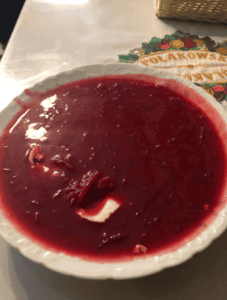
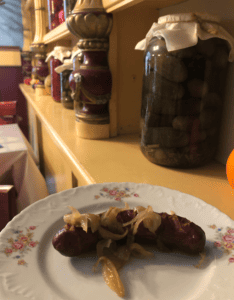
Beetroot Soup, paired with Polish Sausage, is a staple in Polish cuisine. Its origins are deeply rooted in the country’s history, with regional variations adding unique twists to this classic dish. Beetroot Soup, known for its vibrant color and earthy flavor, often symbolizes the heart of Polish culinary tradition.
This combination of soup and sausage represents the warmth of Polish hospitality and the richness of its culinary heritage. Often served during family gatherings and special occasions, it brings people together, symbolizing unity and tradition.
Beetroot Soup is typically made with a blend of beets, vegetables, and sometimes meat, with each recipe varying by region and family tradition. Polish Sausage, a versatile and flavorful component, complements the soup’s earthy tones, creating a balance of flavors that is both hearty and comforting.
Each of these dishes, from the street-side Zapiekanka to the homely Beetroot Soup with Polish Sausage, forms an integral part of Krakow’s culinary identity. They are not just food items; they are storytellers of the city’s history, culture, and community spirit. As we explore these dishes on the Food Tour Krakow, we delve deeper into the essence of what makes Krakow’s cuisine so special and enduring.

Food Tour Krakow: Your Way Into Poland’s Secrets
As we wrap up our culinary journey through Krakow, it’s clear that the Food Tour Krakow offers more than just a taste of traditional dishes. It’s a gateway to the city’s rich history and vibrant culture, expressed through its food.
The tour is a mosaic of experiences, not only showcasing Zapiekanka, Pierogi, and Beetroot Soup with Polish Sausage, but also leading participants through historic bars and lively markets. Each stop is a piece of Krakow’s story, offering a glimpse into the city’s past and present. The tour includes tastings of local drinks like honey-flavored vodka and Polish beer, adding another layer to the culinary adventure.
Exploring Krakow’s Landmarks
Beyond the flavors, the tour takes you through significant city landmarks. From the Jewish Quarter’s rich history to the picturesque Wawel Hill, each site adds depth to the understanding of Krakow’s culinary evolution. The journey through Krakow’s streets, its medieval architecture, and busy markets, all contribute to a full sensory experience.
For those eager to immerse themselves in Krakow’s culinary scene, the Food Tour Krakow is an ideal starting point. It’s an invitation to explore, taste, and celebrate the city’s gastronomic legacy. Whether you’re a history buff, a food enthusiast, or simply someone who loves to explore new cultures, this tour promises a fulfilling and delicious adventure.
In conclusion, Krakow’s food culture is a perfect blend of history, tradition, and modern innovation. By participating in the Food Tour Krakow, you engage with the city’s soul. So, why wait? Book your tour today and embark on a culinary journey that offers a feast for the senses and a deep dive into the heart of Krakow.Explore the Food Tour Krakow and start your culinary adventure!
